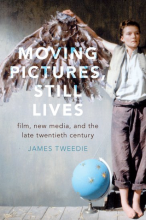Professor Tweedie's new book Moving Pictures, Still Lives is now available from Oxford University Press. The book revisits the cinematic and intellectual atmosphere of the late twentieth century. Against the backdrop of the historical fever of the 1980s and 1990s—the rise of the heritage industry, a global museum-building boom, and a cinematic fascination with costume dramas and literary adaptations—it explores the work of artists and philosophers who complicated the usual association between the past and tradition or the future and modernity. The book retraces the “archaeomodern turn” in media and theory that viewed the past as a repository of abandoned but potentially transformative modern experiments. Three theoretical chapters consider key figures—Walter Benjamin, Gilles Deleuze, and Serge Daney—who grappled with the late twentieth century’s characteristic concerns, including history, memory, and belatedness. It reframes this theoretical work on film as a mourning play for revolutions past and a means of reviving the possibilities of the modern age (and its paradigmatic medium, cinema) during periods of political and cultural retrenchment. Like Daney, the book emphasizes the value of looking at cinema and the century in the “rear-view mirror,” at the aging of a quintessentially modern art like film, and at the phantoms that remain after the passage into the era of new media. The second part of the manuscript, titled “The Cinema of Painters,” is structured around a series of interactions among media, filmmakers, and national traditions. It examines late twentieth-century filmmakers who systematically adopted strategies normally associated with other visual media or art forms, especially painting. Focusing on Alain Cavalier, Terence Davies, Jean-Luc Godard, Peter Greenaway, Derek Jarman, and Agnès Varda, the book concentrates on films that fill the frame with a succession of tableaux vivants, still lifes, illuminated manuscripts, and landscapes. These filmmakers view these devices not through the lens of nostalgia but as portals to the modern past.
The book is now available from Oxford University Press.
